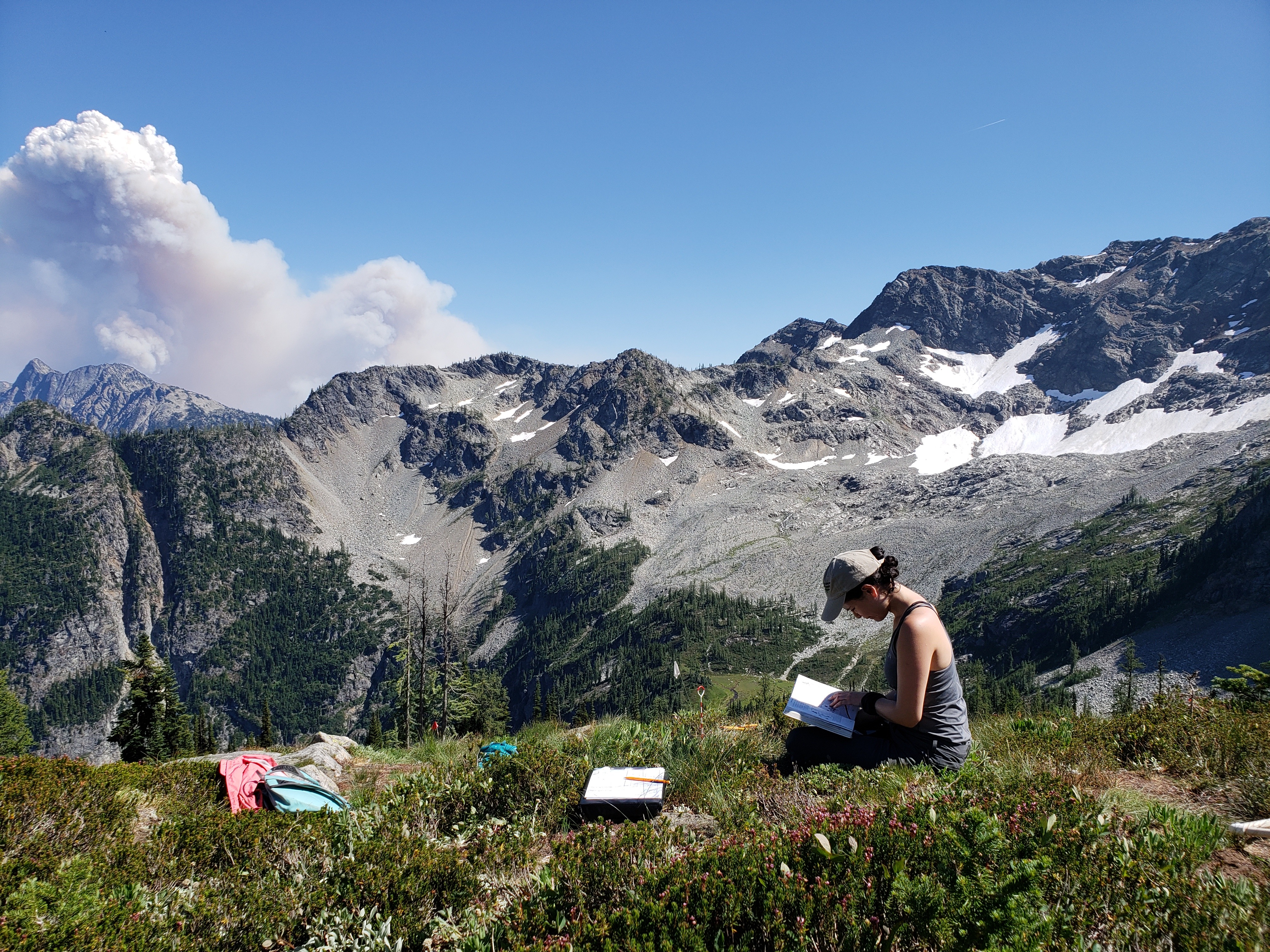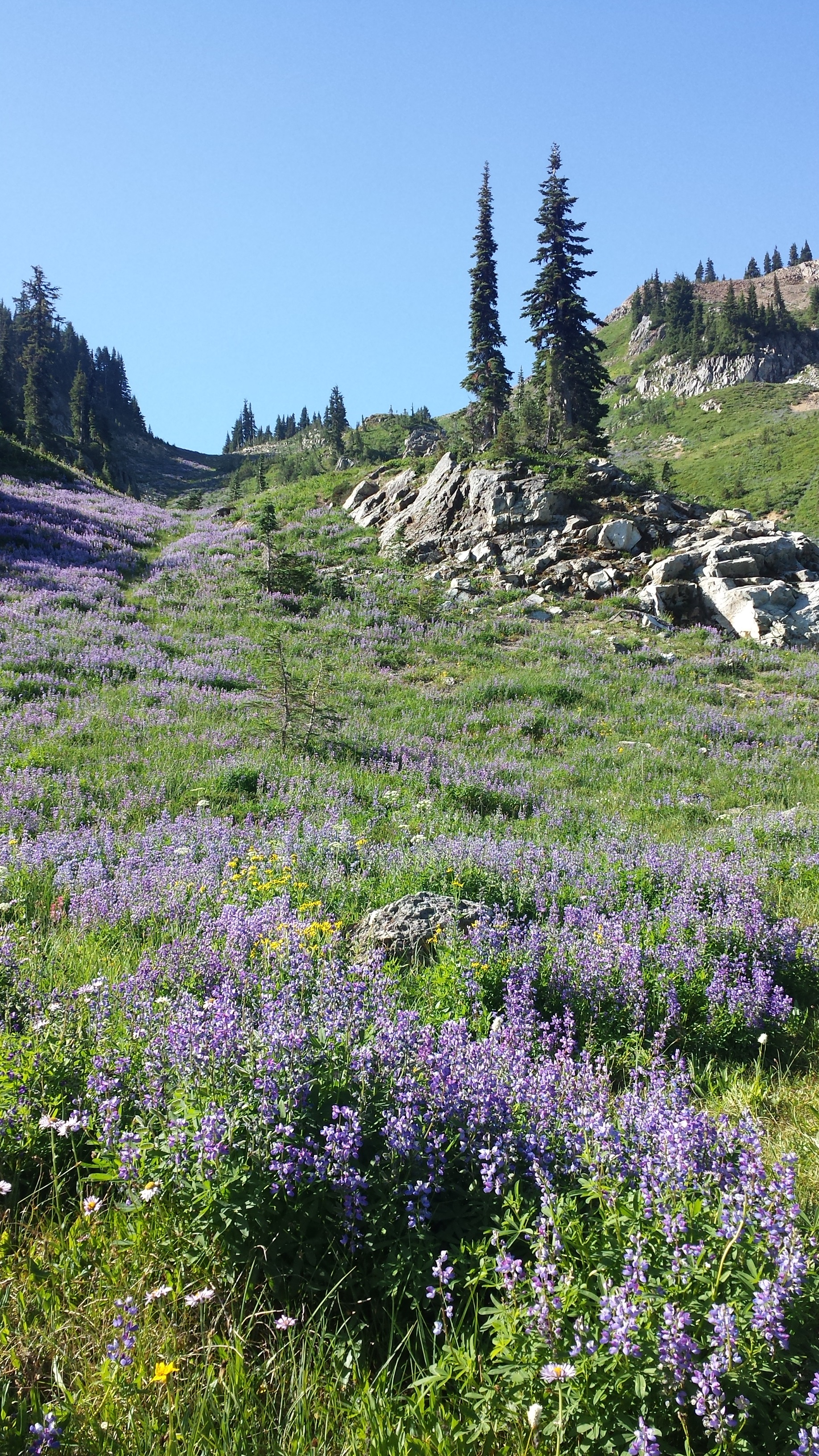
| HOME | PEOPLE | RESEARCH | PUBLICATIONS |
The effects of climate change on forest demography and species distributions
How will climate change influence the distribution and performance of plant species? To answer this question, we need to know what controls range limits, and how those controls differ by species. Climate is thought to determine where species can survive given their physiological tolerances, with biotic interactions such as competition acting to further restrict those distributions. Despite the long acceptance of these ideas by ecologists, we
To explore these questions, we are combining observational monitoring, common garden experiments and statistical modeling to assess the controls over current and future altitudinal range limits of tree species on Mt. Rainier, Washington. Because Mt. Rainier covers large climatic gradients, it is an ideal natural laboratory for exploring how climate change will affect forest and meadow communities. Using field observations, experiments and statistical modeling, we have addressed questions like 1) Which climatic factors limit performance at range limits, and how do these vary among species (e.g. Ettinger et al. 2011, Kroiss & Hille Ris Lambers 2015, Legendre-Fixx et al 2018)?; and 2) What is the relative importance of climate relative to other factors (e.g. competitive interactions, edaphic conditions) for demographic performance (e.g. Hille Ris Lambers et al 2013, Theobald et al 2016, Hille Ris Lambers et al 2016, Ettinger & Hille Ris Lambers 2013 & 2017, Ford et al 2017, Ford et al 2020)?
Ongoing data collection includes monitoring of tree growth and survival (every 5-6 years, >40 years data), seed production, seedling regeneration and microclimate (temperature, snow depth, soil moisture, date of meltout - 10+ years data) in 18 stands located across Mt. Rainier National Park. New Project on Masting: We are just starting to use long-term seed production data, paired with manipulative experiments and camera traps to explore the drivers of masting (temporally variable seed production) and implications of masting for seed predator population dynamics (and the predators of those predators). New Project on Tree Regeneration Niches: In collaboration with Rubén D. Manzanedo and Kristiina Visakorpi (postdocs at ETH Zurich), we are setting up parallel monitoring efforts of seed production and seedling densities in Swiss montane forests, paired with measurements of seedling traits in the greenhouse. Data from both USA and Swiss forest sites will allow us to explore the climatic constraints on tree seedling regeneration, relevant to understanding how rapidly trees will be able to colonize newly suitable habitats with warming climates.
Representative Recent Publications (please email jannekeh@ethz.ch for pdfs of these articles)
- Ettinger & Hille Ris Lambers 2017 (see here, page 32, for a summary of the study)
- Ford & Hille Ris Lambers 2020
- Hille Ris Lambers et al 2013
- Kroiss & Hille Ris Lambers 2015
UW Funding: NSF (Career), NICCR (Department of Energy), University of Washington Royalty Research Fund
Community asessembly and disassembly in a warming world
 How strongly does climate influence the composition of communities? If climate
is the predominant force structuring communities, climate change should
predictably result in the loss of cold-adapted species at the expense of
warm-adapted species in local communities. Alternatively, if climate doesn’t
strongly structure communities or microclimatic refugia buffer communities fromregional climate trends, community composition may not change much with climate
change. However, apparent stasis in community structure with warming can also
arise from the failure of component species to shift their ranges with warming,
due to (for example) recruitment limitation or demographic inertia.
Unfortunately, these two have very different implications; the first suggests
communities may be somewhat resilient to climate change, while the latter implies
lagged community sensitivity, especially as climate change accelerates. To
explore the potential for community resilience vs. sensitivity to recent and
future climate change, myself and Amy Angert
are resurveying plant community composition at >1000 plots located
in Mt. Rainier National Park and North Cascades National Park (WA,
USA). These plots were first
surveyed in the 70's / 80's, and resurveys will allow us to determine
the extent to which plant
communities have already responded to recent warming, and how local
microclimate influences community shifts. We are also conducting
an extensive seed addition experiment on the east and west flanks of
the Cascade Mountains (WA, USA) to assess how macro- and microclimatic effects on regeneration influences seedling recruitment.
How strongly does climate influence the composition of communities? If climate
is the predominant force structuring communities, climate change should
predictably result in the loss of cold-adapted species at the expense of
warm-adapted species in local communities. Alternatively, if climate doesn’t
strongly structure communities or microclimatic refugia buffer communities fromregional climate trends, community composition may not change much with climate
change. However, apparent stasis in community structure with warming can also
arise from the failure of component species to shift their ranges with warming,
due to (for example) recruitment limitation or demographic inertia.
Unfortunately, these two have very different implications; the first suggests
communities may be somewhat resilient to climate change, while the latter implies
lagged community sensitivity, especially as climate change accelerates. To
explore the potential for community resilience vs. sensitivity to recent and
future climate change, myself and Amy Angert
are resurveying plant community composition at >1000 plots located
in Mt. Rainier National Park and North Cascades National Park (WA,
USA). These plots were first
surveyed in the 70's / 80's, and resurveys will allow us to determine
the extent to which plant
communities have already responded to recent warming, and how local
microclimate influences community shifts. We are also conducting
an extensive seed addition experiment on the east and west flanks of
the Cascade Mountains (WA, USA) to assess how macro- and microclimatic effects on regeneration influences seedling recruitment.Representative Recent Publications (please email jannekeh@ethz.ch for pdfs of these articles) Funding: NSF
Climate change and phenology

What controls the wildflower phenology in high mountain meadows? The timing of key life events like reproduction (i.e. phenology) is tightly linked to climate. For example, alpine wildflowers emerge and flower within a few weeks of snow disappearance, and complete their life-cycles before the frost in early autumn. Because annual variability in snow disappearance is large, the timing of seasonal wildflower displays also varies annually, influencing visitation and staffing needs in areas famous for their displays of wildflowers (like Mt. Rainier NP). Additionally, as climate change causes earlier snow disappearance, wildflowers that cannot shift their phenology to match this altered “climate window” may decline, as could other species (e.g. pollinators, bears) whose activities do not shift in concert with the plants whose pollen, nectar, seeds or berries they rely on. Thus, resource managers and conservation biologists are interested in understanding the link between climate and wildflower phenology, as well as in generating long-term annual records of wildflower phenology.
In collaboration with the National Park Service, current and former graduate students, and other Hille Ris Lambers lab affiliates, we have used many approaches to understanding the impacts of climate change on snow dynamics (a strong driver of wildflower phenology in our system), the link between snowmelt and wildflower phenology, and the implications of earlier snowmelt and shifts in wildflower phenology for National Park visitation, pollinators, and patterns of co-flowering. Please check out our MeadoWatch website for more details on our citizen science program MeadoWatch.
Representative Recent Publications (please email jannekeh@ethz.ch for pdfs of these articles)
- Breckheimer et al 2020
- Jenkins et al 2019 (scroll to page 13)
- Sethi et al 2020
- Theobald et al 2017
- Wilson et al 2016
Biology Department
University of Washington
Seattle WA, 98195-1800
Also:
(as of September 2020)
Plant Ecology Group (website under construction)
ETH Zürich, Switzerland